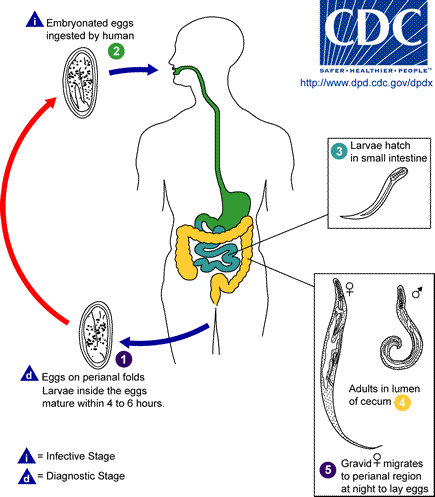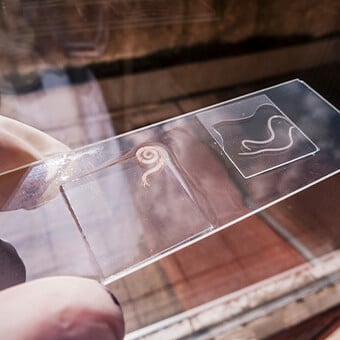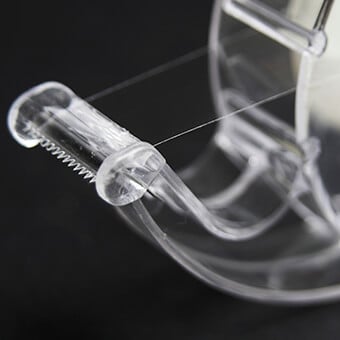Pinworms (Enterobiasis) in Kids and Adults

Pinworm definition and facts
- Pinworm infections are caused by worm-like parasites (Enterobius vermicularis) that infect humans' intestines and rectal/anal areas.
- Young children, school-aged children, and their household members, including adults, are at risk for pinworm infections.
- Pinworms are visible. They range in size from 2-13 mm, are white, and resemble a worm but the pinworm eggs are small, transparent, and can be seen only with a microscope.
- Pinworm infections are spread person-to-person by ingesting pinworm eggs that have contaminated fingers, bed linens, clothing, nightclothes, or other items.
- The major signs and symptoms of pinworm infection are discomfort and itching in the anal/rectal area. Children especially will scratch the rectal/anal area, get eggs on their fingers or underneath their fingernails and transport the infective eggs to bedding, toys, other humans, or back to themselves.
- Other signs and symptoms may include:
- Discomfort in the anal and/or vaginal area
- Rash or skin irritation around the anus or vagina
- Insomnia or difficulty sleeping and/or restlessness due to irritation of the skin
- Pinworms can often be seen on the anal skin or in the stools, sometimes detected in the vagina, and may produce some vaginal discharge
- Some infected individuals may have abdominal pain.
- Some infected individuals can get secondary bacterial infections from intense skin scratching.
- Infrequent infection of the ureters and/or bladder may cause dysuria or bladder discomfort.
- Pinworm eggs hatch into larval forms in the small intestine and then progress to the large intestine where they mature, mate, and progress to the rectal/anal area where females deposit about 10,000-15,000 eggs.
- Diagnosis may be done by a "tape test" and/or by visualizing pinworms in the stools or on the skin near the anus or in the vagina.
- Most primary care or pediatric doctors can diagnose and treat patients with pinworms.
- Several drugs may cure a patient with pinworms when administered over time.
- Natural and/or home remedies are available, but patients should check with their doctor before using them.
- Good hygiene can help prevent pinworm infections.
What are pinworms?
Pinworm infection is an infection of the large intestine and anal area by a small, white parasite that resembles a "worm." The medical name for the parasite is Enterobius vermicularis, but it is commonly termed a pinworm in both the lay and medical literature. These parasites are also termed seatworms or threadworms, and the infections are medically termed enterobiasis, oxyuriasis, or helminthiasis. Pinworms and other helminthic parasitic worms (which, as a group, are termed helminths) feed off of the host animal by adsorbing nutrients from the host animal. Pinworm infections are the most common helminth infection that occurs in the US. Pinworms only infect humans. Dogs, cats, or other animals cannot become infected.

Who gets pinworms?
Pinworm is the most common parasitic worm infection in the United States, and the majority of pinworm infections worldwide occur in children, in temperate climates.
Pinworms in children
The highest rates of pinworm infection occur in school-age children. They are followed by preschoolers. Institutional settings including daycare facilities often harbor multiple individuals (adults and children) with pinworm infections. Sometimes, nearly half of the children may be infected in a daycare facility.
Pinworms in adults
Pinworm infection often occurs in more than one family member. Adults are less likely to have pinworm infection, except for mothers of infected children. However, adult sexual partners can transfer the eggs to each other. Pinworms also may infect the vagina and urethra.
What are the symptoms of pinworms in children and adults?

If symptoms are present, they are similar in both children and adults. The signs and symptoms may include one or more of the following:
- Intense (pruritus) around the anus and/or vagina
- Discomfort in the anal and/or vaginal area
- Rash or skin irritation around the anus or vagina
- Insomnia or difficulty sleeping and/or restlessness due to irritation of the skin
- Pinworms often can be seen on the anal skin or in the stools, sometimes detected in the vagina, and may produce some vaginal discharge
Less common symptoms include:
- Abdominal pain
- Secondary bacterial infections from intense skin scratching
- Infrequent infection of the ureters and/or bladder may cause dysuria or bladder discomfort
Many infected children and adults have few or no symptoms but, if the infection is heavy, the symptoms can be correspondingly more severe.

What do pinworms and their eggs look like (pinworm pictures)?
The pinworms are white, can be seen with the naked eye (no magnification), and are about the length of a staple (about 8-13 mm for female and 2-5mm for male worms). The eggs that are laid by the female worms are not visible as they are about 55 micrometers in diameter and are translucent (see Figure 1).
The male and female worms live for the most part within the rectum of humans but have a life cycle in humans that involves rectal/oral transmission (see Figure 2).
While an infected person is asleep, female pinworms leave the intestines through the anus and deposit eggs on the skin around the anus. This causes itching and irritation of the surrounding area; children especially will scratch the rectal/anal area, get eggs on their fingers or underneath their fingernails and transport the infective eggs to bedding, toys, other humans, or back to themselves. The eggs hatch into larval forms in the small intestines and then progress to the large intestine where they mature, mate, and progress to the rectal/anal area where females deposit about 10,000-15,000 eggs.

How do you get pinworms?
Pinworm infection is spread person to person. The symptoms of pinworm infection are caused by the female pinworm moving and laying her eggs, and this usually occurs at night. Within a few hours of being deposited on the skin around the anus, pinworm eggs become infective (capable of infecting another person). They can survive up to two weeks on nightclothes, bed linen, or other objects. Infection is acquired when these eggs are accidentally swallowed, usually due to inadequate hand washing by the parents and children. However, eggs on bedding or other objects that are touched while the eggs are still viable can cause infection or reinfection of people.
Can you get pinworms in the vagina?
Yes, pinworms can infect the vagina (about 20% of infected girls). Infrequently, the pinworms can go on to infect the Fallopian tubes and other structures.

Which specialties of doctors treat pinworms?
The majority of pinworm-infected patients can be treated by the patient's primary care or pediatric physician. Rarely, an infectious disease specialist, parasitologist, OB/GYN, gastroenterologist, or dermatologist is consulted.
How is the tape test used in diagnosing pinworms?
If pinworms are suspected, transparent adhesive tape or a pinworm paddle (supplied by your health care professional) are applied to the anal region. The eggs (and sometimes the parasites themselves) adhere to the sticky tape or paddle and are identified by examination under a microscope. The test is sometimes referred to as "the Tape Test."
The test should be done as soon the affected individual wakes up in the morning (because bathing or having a bowel movement may remove most eggs and parasites). The exam may require several samples for diagnosis. Samples taken from under the fingernails may also contain eggs (since scratching of the anal area is common by affected individuals).
At night, the adult worms can sometimes be seen directly in bedclothes or around the anal area: this is another good time to detect the parasites with the transparent adhesive tape method.
Are there natural or home remedies that treat pinworms?
There are many natural and/or home remedies for pinworms although there is a lack of data to support claims. Some of the many suggested remedies include the following:
- Garlic
- Coconut (grated)
- Grapefruit seed extract and paste
- Grated carrots daily
- Onion juice three times per day for two days
- Pumpkin seeds
- Wormwood extract
The above are just a few of the remedies. Check with your doctors before using these remedies.

What are treatment options and medications for pinworms?
Medication to get rid of pinworms include:
- Usually, a single tablet of mebendazole (Vermox) is used as pinworm medicine. This can sometimes be repeated a week later or, if the infection persists, the medication is given again three weeks later. Some clinicians recommend a treatment protocol of a drug dose every three weeks, three times so that the person has effective drug treatment for about nine weeks total. Vermox has been discontinued in the U.S., but stocks are still available in some pharmacies.
- Another effective medication is albendazole (Albenza) but it may require other medications to reduce the inflammation of the central nervous system, a side effect of the drug. Albendazole is well tolerated with minimal side effects due to minimal systemic absorption.
- Pyrantel pamoate (Pin-Rid, Pin-X) is available over the counter for pinworm after confirmation of the diagnosis by a licensed health care practitioner. Drugs available over the counter vary from country to country. Pyrantel is the treatment of choice for pregnant women.
- To treat pinworms affecting urinary and genital organs, combination therapy with oral mebendazole (Vermox) and ivermectin (Stromectol) for the worms as well as a topical therapy for the eggs may be required.
Most pinworm infections are treated at home with the above medications. However, reinfection is fairly common. To both reduce the chances for reinfection and to help prevent others from getting pinworms, see the prevention section.
Pinworm infections can be cured; usually by three doses of medication, each three weeks apart. Individuals are encouraged to follow-up with their doctor to be sure treatment has been effective.
What happens if pinworms aren't treated?
Untreated pinworms may cause or have a role in causing:
- Diarrhea
- Significant malabsorption of food
- Weight loss
- Genital itching
- Bedwetting (enuresis)
- Main during urination (dysuria)
- Vaginal discharge can be associated with genital skin irritation and rash
Complications may include
- endometriosis,
- salpingitis,
- urethritis,
- urinary tract infection (UTI),
- vulvovaginitis, and
- possibly appendicitis.
Is it possible to prevent pinworms?
Good hygiene will help reduce the spread of the parasites.
- Hand washing after handling bedding, diapers, underwear, and other items like child toilet seats, toys, changing tables, and other surfaces that may contain the infective pinworm eggs will also help prevent spread of the parasite.
- Cleaning under the fingernails and not biting the fingernails will also help reduce the chance of contacting the parasites.
- Change and wash clothes in hot water daily, especially underwear, to help prevent spreading the disease.
- Treating everyone infected in a household at the same time may help prevent recurrence and spread to others.
- Because the eggs remain infective for up to three weeks in a moist environment, prevention of spread and reinfection is difficult but possible.


